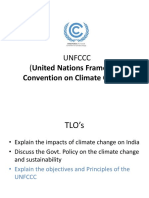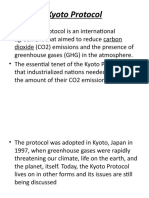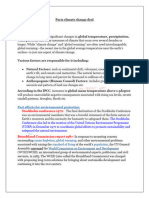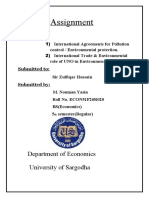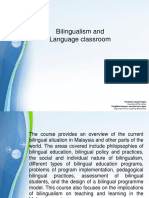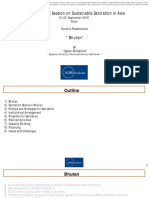Kyoto Agenda Roles
Kyoto Agenda Roles
Uploaded by
芳凯Copyright:
Available Formats
Kyoto Agenda Roles
Kyoto Agenda Roles
Uploaded by
芳凯Original Description:
Copyright
Available Formats
Share this document
Did you find this document useful?
Is this content inappropriate?
Copyright:
Available Formats
Kyoto Agenda Roles
Kyoto Agenda Roles
Uploaded by
芳凯Copyright:
Available Formats
KYOTO PROTOCOL
INTRODUCTION
The Kyoto Protocol is a protocol
to the United Nations
Framework Convention on
Climate Change (UNFCCC or
FCCC), aimed at fighting global
warming. The UNFCCC is an
international environmental
treaty with the goal of achieving
the "stabilisation of greenhouse
gas concentrations in the
atmosphere at a level that
would prevent dangerous
anthropogenic interference
with the climate system."
The major feature of the Kyoto Protocol is that it sets binding targets for
37 industrialized countries and the European community for reducing
greenhouse gas (GHG) emissions. These amount to an average of five per
cent against 1990 levels over the five-year period 2008-2012.
The major distinction between the Protocol and the Convention is that
while the Convention encouraged industrialised countries to stabilize GHG
emissions, the Protocol commits them to do so.
Kyoto Protocol to the United Nations Framework Convention on Climate
Change
Kyoto Protocol participation map as of February, 2012
Green = Countries that have ratified the treaty
(Annex I & II countries in dark green)
Brown = No intention to ratify
Red = Countries which have withdrawn from the Protocol
Grey = no position taken or position unknown
HISTORY
The Protocol was initially adopted on
11 December 1997 in Kyoto, Japan,
and entered into force on 16
February 2005. As of September
2011, 191 states have signed and
ratified the protocol. The only
remaining signatory not to have
ratified the protocol is the United
States. Other United Nations member
states which did not ratify the
protocol are Afghanistan, Andorra
and South Sudan. In December 2011,
Canada renounced the Protocol.
The Kyoto Protocol decided upon:
1) emission-reduction targets of greenhouse gases
for each of the member countries
2) a greenhouse gas emission-trading program
3) holding future meetings to set penalties for
violators of the established targets and regulation
rules of the emission-trading program.
In 2001, George W. Bush was elected president of the
USA. Unlike his predecessor, President Clinton, President
Bush did not support the Protocol and announced that the
United States withdraws the possibility of ratifying it.
This act put into question the whole concept of addressing
the issues of climate change on a global level.
Furthermore, in order for the Protocol to be put into action
it had to be ratified by at least 55 nations of the UN
Framework Convention, with developed countries
representing a total of 55% of the greenhouse gas
emissions in 1990. With US holding a 36% portion of this
share, a ratification seemed a difficult task.
The Kyoto Protocol finally came into effect on February 16,
2005, 7 years after it was first negotiated, when the goal
of getting countries responsible for a total of 55% of the
global emissions was achieved with the signature of Russia
ratifying the document.
KYOTO PROTOCOL
Under the Protocol, 37 countries ("Annex I countries") commit themselves
to a reduction of four greenhouse gases (GHG) (carbon dioxide, methane,
nitrous oxide, sulphur hexafluoride) and two groups of gases
(hydrofluorocarbons and perfluorocarbons) produced by them, and all
member countries give general commitments.
At negotiations, Annex I countries (including the US) collectively agreed to
reduce their greenhouse gas emissions by 5.2% on average for the period
2008-2012. This reduction is relative to their annual emissions in a base
year, usually 1990. Since the US has not ratified the treaty, the collective
emissions reduction of Annex I Kyoto countries falls from 5.2% to 4.2%
below base year.
Countries with commitments under the Kyoto Protocol to limit or
reduce greenhouse gas emissions must meet their targets primarily
through national measures. As an additional means of meeting these
targets, the Kyoto Protocol introduced three market-based mechanisms,
thereby creating what is now known as the carbon market.
The Kyoto mechanisms are:
-Emissions Trading
-The Clean Development Mechanism (CDM)
-Joint Implementation (JI)
JI and CDM are the two project-based mechanisms which feed the carbon
market. JI enables industrialized countries to carry out joint
implementation projects with other developed countries, while the CDM
involves investment in sustainable development projects that reduce
emissions in developing countries.
The carbon market is a key tool for reducing emissions worldwide. It was
worth 30 billion USD in 2006 and is growing.
The Kyoto mechanisms:
-Stimulate sustainable development through technology transfer and
investment
-Help countries with Kyoto commitments to meet their targets by
reducing emissions or removing carbon from the atmosphere in other
countries in a cost-effective way
-Encourage the private sector and developing countries to contribute to
emission reduction efforts
OBJECTIVES
The main aim of the Kyoto Protocol is to contain emissions of the main
anthropogenic (i.e., human-emitted) greenhouse gases (GHGs) in ways
that reflect underlying national differences in GHG emissions, wealth, and
capacity to make the reductions.
The treaty follows the main principles agreed in the original 1992 UN
Framework Convention. According to the treaty, in 2012, Annex I Parties
who have ratified the treaty must have fulfilled their obligations of
greenhouse gas emissions limitations established for the Kyoto Protocol's
first commitment period (20082012).
The ultimate objective of the UNFCCC is the "stabilization of greenhouse
gas concentrations in the atmosphere at a level that would prevent
dangerous anthropogenic interference with the climate system. Even if
Annex I Parties succeed in meeting their first-round commitments, much
greater emission reductions will be required in future to stabilize
atmospheric GHG concentrations.
The five principal concepts of the Kyoto Protocol are:
1) Commitments for the Annex I Parties. The main feature of the Protocol lies
in establishing commitments for the reduction of greenhouse gases that
are legally binding for Annex I Parties. The Annex I Parties took on legally
binding commitments based on the Berlin Mandate, which was a part of
UNFCCC negotiations leading up to the Protocol.
2) Implementation. In order to meet the objectives of the Protocol, Annex
I Parties are required to prepare policies and measures for the
reduction of greenhouse gases in their respective countries. In addition,
they are required to increase the absorption of these gases and utilize
all mechanisms available, such as joint implementation, the clean
development mechanism and emissions trading, in order to be
rewarded with credits that would allow more greenhouse gas emissions
at home.
3) Minimizing Impacts on Developing Countries by establishing an
adaptation fund for climate change.
4) Accounting, Reporting and Review in order to ensure the integrity of the
Protocol.
5) Compliance. Establishing a Compliance Committee to enforce compliance
with the commitments under the Protocol.
AGENDA 21 in BRAZIL
WHAT IS AGENDA 21?
A global action plan for sustainable development
into the 21st century.
Sustainable development is a process that aims to
meet the needs of the present generation without
harming the ability of future generations to meet
their needs.
AGENDA 21
The outcome of the United Nations Conference on
Environment and Development (UNCED) held in Rio
de Janeiro, Brazil in 1992.
To encourage cooperation among nations to sustain
life on earth.
The central belief is that all countries can protect the
environment while simultaneously experiencing
growth.
Adopted by more than 178 Governments.
Comprises 40 chapters (arranged in 4 Sections)
ROLES OF EDUCATION
Agenda 21 states that 'Education is critical for
promoting sustainable development and improving
the capacity of the people to address environment and
development issues'.
Both formal and non-formal education are
essential to change people's attitudes so that they
have the capacity to assess and address their
sustainable development concerns.
To be effective, environment and development
education should deal with the dynamics of both the
physical/biological and socio-economic environment
and human (which may include spiritual) development,
should be integrated in all disciplines, and should
employ formal and non-formal methods and effective
means of communication.
PROPOSED ACTIVITIES
Educational authorities should promote proven
educational methods and the development of innovative
teaching methods for educational settings. They should
also recognize appropriate traditional education systems
in local communities.
Educational authorities, with the appropriate assistance
from community groups or non-governmental
organizations are recommended to set up pre-service
and in-service training programmes for all teachers,
administrators, educational planners as well as non-
formal educators in all sectors, addressing the nature and
methods of environmental and development education
and making use of relevant experience of non-
governmental organizations.
Relevant authorities should ensure that every school
is assisted in designing environmental activity work
plans, with the participation of students and staff.
Schools should involve schoolchildren in local and
regional studies on environmental health, including
safe drinking water, sanitation and food and
ecosystems and in relevant activities, linking these
studies with services and research in national parks,
wildlife reserves, ecological heritage sites etc.
Governments should affirm the rights of indigenous
peoples, by legislation if necessary, to use their
experience and understanding of sustainable
development to play a part in education and training.
ROLES OF AWARENESS-RAISING PROGRAMMES
There is still a considerable lack of awareness of
human activities and the environment due to
inaccurate or insufficient information.
There is a need to increase public sensitivity to
environment and development problems and
involvement in their solutions and foster a sense of
personal environmental responsibility and greater
motivation and commitment towards sustainable
development.
PROPOSED ACTIVITIES
Countries and regional organizations should be
encouraged to provide public environmental and
development information services for raising the
awareness of all groups, the private sector and
particularly decision makers.
Countries should promote environmentally sound leisure
and tourism activities, building on The Hague Declaration
of Tourism (1989) and the current programmes of the
World Tourism Organization and UNEP, making suitable
use of museums, heritage sites, zoos, botanical gardens,
national parks, and other protected areas.
THE AIM OF DEVELOPMENT
EDUCATION AND AWARENESS
RAISING
The aim of development education and awareness raising is
to enable every person to have life-long access to
opportunities to be aware of and to understand global
development concerns and the local and personal relevance
of those concerns, and to enact their rights and
responsibilities as inhabitants of an interdependent and
changing world by affecting change for a just and sustainable
world.
OBJECTIVES/ROLES
To encourage non-governmental organisations,
mass media and other concerned organisations for
promoting awareness among the people at all
levels
To promote environment education through
existing educational/scientific/research
institutions
To ensure training and manpower development in
environment education
To mobilise peoples awareness for the
preservation and conservation of environment
Key programmes/ activities launched
under Environmental Education,
Awareness and Training scheme over
the years are :
National Environment Awareness Campaign (NEAC)
The Ministry of Environment
and Forests (MoEF),
Government of India started
The National Environment
Awareness Campaign (NEAC)
in 1986 with the aim of
creating environmental
awareness at all levels of
society.
Eco Clubs & National Green Corps
(NGC)
'Eco Clubs' were constituted by MoEF with
objectives to educate school children about
their immediate environment and impart
knowledge about the eco-systems, their
interdependence and their need for survival.
For example :-
Involving them in various environmental
activities through visits and demonstrations
Involving them in the efforts of environmental
preservation
Global Learning & Observations to
Benefit the Environment (GLOBE)
Through this they learn about scientific
protocols and perform environmental learning
activities, which have already been introduced
as theory in the textbooks.
The GLOBE programme not only helps the
students to appreciate the contents of the
textbooks through better understanding but
also assists them in gaining complete
knowledge of environment.
THANK YOU
You might also like
- REI CaseDocument8 pagesREI CaseSyahrizka100% (1)
- BS8515 Data SheetDocument46 pagesBS8515 Data SheetYanick Armando Camangue75% (4)
- Teaching Materials ChecklistDocument2 pagesTeaching Materials Checklist芳凯100% (3)
- Bioversal QF: Material Safety Data SheetDocument24 pagesBioversal QF: Material Safety Data Sheetfareedee50% (2)
- Xypex Chemical Corporation WaterproofingDocument292 pagesXypex Chemical Corporation WaterproofingalbijayNo ratings yet
- Kyoto Protocol 2Document30 pagesKyoto Protocol 2dr.vyshnavi0909No ratings yet
- Kyoto ProtocolDocument18 pagesKyoto Protocolcoolfaiz3100% (1)
- 1.1.1.1. Key Aspects of The Kyoto ProtocolDocument7 pages1.1.1.1. Key Aspects of The Kyoto ProtocolShazma KhanNo ratings yet
- Kyoto Protocol As The Solution For Climate ChangeDocument4 pagesKyoto Protocol As The Solution For Climate ChangeTria_Octaviant_8507No ratings yet
- Unfccc (United Nations Framework: Convention On Climate Change)Document54 pagesUnfccc (United Nations Framework: Convention On Climate Change)Nagaraj Navalgund100% (1)
- Environmental Legislation in IndiaDocument13 pagesEnvironmental Legislation in IndiaRishabh Shukla XII HNo ratings yet
- Paris Climate Agreement SummaryDocument3 pagesParis Climate Agreement SummaryDorian Grey100% (1)
- Arbitrator AppointmentDocument34 pagesArbitrator AppointmentIqram Meon100% (1)
- Kyoto MontrealDocument29 pagesKyoto MontrealShubhamNo ratings yet
- Paris Agreement 13 Point SummaryDocument3 pagesParis Agreement 13 Point SummaryPedro TinocoNo ratings yet
- 001.kyoto ProtocolDocument6 pages001.kyoto Protocolmuna saputraNo ratings yet
- Draft MOU Foremost Pert - Revision v2.0Document3 pagesDraft MOU Foremost Pert - Revision v2.0carlgerNo ratings yet
- Waste To Energy PlantDocument35 pagesWaste To Energy PlantZerlyn JoebeNo ratings yet
- Kyoto ProtocolDocument18 pagesKyoto Protocolimahere_suryaNo ratings yet
- Paris Agreement SummaryDocument2 pagesParis Agreement SummaryAlejandro Fox Santiago100% (1)
- Time Line of The Case @BDocument7 pagesTime Line of The Case @BprathlakshmiNo ratings yet
- Module 2 Kyoto Protocol and SDGDocument24 pagesModule 2 Kyoto Protocol and SDGArya RajNo ratings yet
- Global Climate Action in The Form of Treaties & Conferences: Kyoto Protocol & Paris AgreementDocument4 pagesGlobal Climate Action in The Form of Treaties & Conferences: Kyoto Protocol & Paris AgreementyskstogtyNo ratings yet
- Rio Declaration and Kyoto ProtocolDocument5 pagesRio Declaration and Kyoto ProtocolCaressa PerezNo ratings yet
- Kyoto 2Document20 pagesKyoto 2pia.malik2009No ratings yet
- Kyoto ProtocolDocument2 pagesKyoto Protocolarohianand27100908No ratings yet
- Kyoto ProtocolDocument16 pagesKyoto ProtocolChanpreet GulatiNo ratings yet
- CA Lecture 2 Climate Change (Part 1)Document15 pagesCA Lecture 2 Climate Change (Part 1)anandamozhi sankarNo ratings yet
- Hanna B - Ass # 2 ENSCIEDocument5 pagesHanna B - Ass # 2 ENSCIEbalmeshannaandreiNo ratings yet
- ClimateDocument6 pagesClimateAdina AnwarNo ratings yet
- 23IN608 - Aman KumarDocument7 pages23IN608 - Aman KumarAman KumarNo ratings yet
- KYOTODocument1 pageKYOTOKumar IshanNo ratings yet
- Climate Change and International ProtocolsDocument27 pagesClimate Change and International ProtocolsTania BanerjeeNo ratings yet
- UNFCCCDocument33 pagesUNFCCCleticiadmagesaNo ratings yet
- International Conventions - 1Document17 pagesInternational Conventions - 1lokendrajadon1973No ratings yet
- CC 2 1668595341968Document68 pagesCC 2 1668595341968shweta23mainwalNo ratings yet
- The Environmental Global Agenda: Hady Putranto Haliamah Tusya Diah Hestriyana PutriDocument25 pagesThe Environmental Global Agenda: Hady Putranto Haliamah Tusya Diah Hestriyana PutriauliaNo ratings yet
- Lecture-20_Global Efforts and Agreements for Climate Change ActionDocument16 pagesLecture-20_Global Efforts and Agreements for Climate Change Actiongitu0853No ratings yet
- BG KyotoprotocolDocument5 pagesBG KyotoprotocolPawan DesaiNo ratings yet
- Organisations and AgreementsDocument2 pagesOrganisations and Agreementsharinisuresh1509No ratings yet
- Kyoto Protocol and BeyondDocument8 pagesKyoto Protocol and BeyondKomal AgarwalNo ratings yet
- Isha TripathiDocument20 pagesIsha TripathiShashikant MishraNo ratings yet
- Earth Summit Onwards - Year 2Document23 pagesEarth Summit Onwards - Year 2balyan7ayushiNo ratings yet
- CDM Potential in Small Hydro FinalDocument64 pagesCDM Potential in Small Hydro Finalanu141No ratings yet
- Environment Economics AssignmentDocument11 pagesEnvironment Economics AssignmentMuhammad Nouman YasinNo ratings yet
- UNFCCC - United Nations Framework Convention On Climate ChangeDocument6 pagesUNFCCC - United Nations Framework Convention On Climate Changeuday KumarNo ratings yet
- The Kyoto Protocol Is RDKTCDocument4 pagesThe Kyoto Protocol Is RDKTCSatyam PandeyNo ratings yet
- Homework: Name: Arianna Villavicencio EcologyDocument5 pagesHomework: Name: Arianna Villavicencio Ecologyari2222villavicencioNo ratings yet
- Kyoto Protocol - FactsDocument13 pagesKyoto Protocol - FactsPatricia BautistaNo ratings yet
- International ConventionsDocument15 pagesInternational Conventionskarimbenzemaa135No ratings yet
- download-216Document11 pagesdownload-21635.11A2. Lê Minh TrườngNo ratings yet
- Kyoto ProtocolDocument29 pagesKyoto ProtocolSwatiNo ratings yet
- The Kyoto Protocol and Copenhagen Climate Change ConferenceDocument31 pagesThe Kyoto Protocol and Copenhagen Climate Change ConferenceShivam TanwarNo ratings yet
- DF21 Empc Assignment 2Document9 pagesDF21 Empc Assignment 2frederick ChelelwaNo ratings yet
- Wa0006.Document5 pagesWa0006.BandosNo ratings yet
- Climate Change-2Document108 pagesClimate Change-2tituNo ratings yet
- Koyoto ProtocolDocument3 pagesKoyoto ProtocolAkash AgarwalNo ratings yet
- Kyoto ProtocolDocument3 pagesKyoto ProtocolBharat pschyo MarinerNo ratings yet
- 0 Environmental Law ProjectDocument25 pages0 Environmental Law ProjectChoudhary Shadab phalwanNo ratings yet
- Kyoto ProtocolDocument16 pagesKyoto ProtocolAhmad Khubaib AdnanNo ratings yet
- International Agreements and ProgrammesDocument33 pagesInternational Agreements and Programmesaakaankshaagupta20No ratings yet
- Clean Development Mechanism Under The Kyoto ProtocolDocument10 pagesClean Development Mechanism Under The Kyoto ProtocolBirmati YadavNo ratings yet
- Unfccc and Kyoto ProtocolDocument13 pagesUnfccc and Kyoto ProtocolCherry May SanchezNo ratings yet
- Global Responses and AccordsDocument5 pagesGlobal Responses and AccordsGopal PanigrahiNo ratings yet
- Kyoto Protocol RevDocument23 pagesKyoto Protocol RevAjay SinghNo ratings yet
- Graphic Novel - Group 3 (Simajag)Document9 pagesGraphic Novel - Group 3 (Simajag)芳凯No ratings yet
- A. Read The Passage Below and Answer The Questions That FollowDocument2 pagesA. Read The Passage Below and Answer The Questions That Follow芳凯No ratings yet
- Definition & Theories On Bilingualism: Powerpoint TemplatesDocument16 pagesDefinition & Theories On Bilingualism: Powerpoint Templates芳凯100% (2)
- Year 5 Lesson Plan Unit 11 Listening and SpeakingDocument3 pagesYear 5 Lesson Plan Unit 11 Listening and Speaking芳凯100% (1)
- Bilingualism and Language Classroom: Powerpoint TemplatesDocument10 pagesBilingualism and Language Classroom: Powerpoint Templates芳凯100% (1)
- EDU 3083i RevisionDocument16 pagesEDU 3083i Revision芳凯No ratings yet
- Hip ChecklistDocument6 pagesHip Checklist芳凯25% (4)
- Leadership TheoriesDocument13 pagesLeadership Theories芳凯No ratings yet
- I Pa TranscriptionDocument19 pagesI Pa Transcription芳凯No ratings yet
- EDU 3083i RevisionDocument16 pagesEDU 3083i Revision芳凯No ratings yet
- Introduction To Research Methods in Education: LAM-PT05-02Document7 pagesIntroduction To Research Methods in Education: LAM-PT05-02芳凯No ratings yet
- Selecting Methods and Materials PDFDocument35 pagesSelecting Methods and Materials PDF芳凯No ratings yet
- 56 - Formative Assessments ExamplesDocument59 pages56 - Formative Assessments Examplesapi-290541111100% (1)
- Words of The Day Words of The DayDocument4 pagesWords of The Day Words of The Day芳凯No ratings yet
- Microsoft Office 2010 Serial Key Asafdfgerrqfewf AsafdfgerrqfewfDocument1 pageMicrosoft Office 2010 Serial Key Asafdfgerrqfewf Asafdfgerrqfewf芳凯No ratings yet
- Managing Diversity ICELD Edited 1 Feb Oct. 2015Document14 pagesManaging Diversity ICELD Edited 1 Feb Oct. 2015芳凯No ratings yet
- TSL 3073 Teaching Writing Skills For Esl Primary Classroom: Tutorial Week 3Document15 pagesTSL 3073 Teaching Writing Skills For Esl Primary Classroom: Tutorial Week 3芳凯No ratings yet
- Luton Borough Council Carbon Management Plan June 2010Document37 pagesLuton Borough Council Carbon Management Plan June 2010Andy StrangeNo ratings yet
- GG Kanda LamaDocument3 pagesGG Kanda LamaAmila DayarathnaNo ratings yet
- Water Seepage in Building Protection MeasuresDocument1 pageWater Seepage in Building Protection Measuressatnam1979No ratings yet
- Country Presentation: BhutanDocument14 pagesCountry Presentation: BhutanADBI EventsNo ratings yet
- Abstractbook Oral 050603Document447 pagesAbstractbook Oral 050603Anonymous IlQeZUokWNo ratings yet
- Private Treatment Septic TankDocument7 pagesPrivate Treatment Septic TankpersonaNo ratings yet
- Fly Screen: Ventilated Improved Double Pit (VIDP) ToiletDocument1 pageFly Screen: Ventilated Improved Double Pit (VIDP) Toiletgkumar77No ratings yet
- Rotamat Sludge Acceptance Plant Ro 3: The Quality Company - WorldwideDocument4 pagesRotamat Sludge Acceptance Plant Ro 3: The Quality Company - WorldwideUhwan SubhanNo ratings yet
- Method 1A-Sample and Velocity Traverses For Stationary Sources With Small Stacks or DuctsDocument4 pagesMethod 1A-Sample and Velocity Traverses For Stationary Sources With Small Stacks or DuctsBenoitNo ratings yet
- Y4263e17 PDFDocument1 pageY4263e17 PDFDaniel AfedorNo ratings yet
- PDF Free Download Here Pdfsdocuments2com PDFDocument2 pagesPDF Free Download Here Pdfsdocuments2com PDFAngelo TabbayNo ratings yet
- Water Resources and EngineeringDocument6 pagesWater Resources and EngineeringJoery Jr EsperonNo ratings yet
- EIA BurigangaDocument14 pagesEIA BurigangaArif Reza TamalNo ratings yet
- BSE Plumbing Offer of DFCC at KurunegalaDocument20 pagesBSE Plumbing Offer of DFCC at KurunegalaTharinduPrasadNo ratings yet
- Scour CalDocument2 pagesScour CalAnonymous O404LiV4CNo ratings yet
- of Energy CrisesDocument11 pagesof Energy CrisesAannaa DisuazaNo ratings yet
- 2 - Water Quality Analysis and ManagementDocument29 pages2 - Water Quality Analysis and ManagementAntonio Z Manchete100% (3)
- WWW - Gov.za: List of National Environmental and Related Legislation in South AfricaDocument3 pagesWWW - Gov.za: List of National Environmental and Related Legislation in South AfricagayneNo ratings yet
- De Thi Hoc Ky 2 Mon Tieng Anh Lop 10 Thi Diem Truong THPT Duong Xa Ha NoiDocument6 pagesDe Thi Hoc Ky 2 Mon Tieng Anh Lop 10 Thi Diem Truong THPT Duong Xa Ha NoiVan DoNo ratings yet
- Sample Pre and Post Activity Evaluation SummaryDocument3 pagesSample Pre and Post Activity Evaluation SummaryJZ SQNo ratings yet
- Stripping, Stockpiling, Site Preparation, and Spreading TopsoilDocument2 pagesStripping, Stockpiling, Site Preparation, and Spreading TopsoilJeremy NicanorNo ratings yet
- The Ultimate TailwindDocument8 pagesThe Ultimate TailwindMohamad AsrulNo ratings yet
- NRC Letter To CDPHE On Piñon Ridge Uranium MillDocument3 pagesNRC Letter To CDPHE On Piñon Ridge Uranium MillInformation Network for Responsible MiningNo ratings yet
- Gilles Boudreau English c.v.2Document5 pagesGilles Boudreau English c.v.2GillesB123No ratings yet
- Toxic Waste Dumping in Somalia and Its Impact On Human RightsDocument15 pagesToxic Waste Dumping in Somalia and Its Impact On Human RightsAbdirahmaan AliNo ratings yet
- Cópia de Atividade 10 9o LI Environment Linking Words and Graphic SymbolsDocument6 pagesCópia de Atividade 10 9o LI Environment Linking Words and Graphic SymbolsJessica NeutonNo ratings yet









